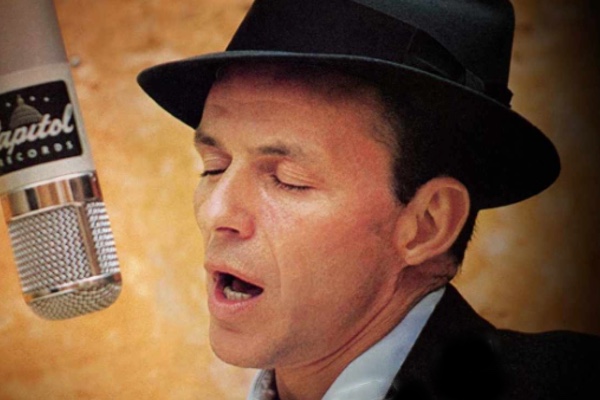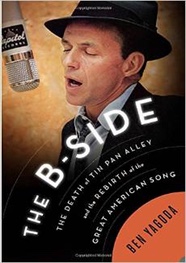Review of Ben Yagoda's "The B-Side: The Death of Tin Pan Alley and the Rebirth of the Great American Song"

Like Elijah Wald’s How the Beatles Destroyed Rock ‘N’ Roll: An Alternative History of American Popular Music (2009), Ben Yagoda’s The B-Side: The Death of Tin Pan Alley and the Rebirth of the Great American Song is an excellent book about American popular music with an utterly misleading title. Wald doesn’t focus on the Beatles, and Yagoda talks a lot about the life and even the death of American “standards,” but relatively little about their “rebirth.” And it’s unclear what “the B-Side” has to do with anything in the book. Earth to publishers: you’re doing your authors no favors with cutesy stuff like this.
 Both Wald and Yagoda cover about two-thirds of the 20th
century, but Yagoda is most interested in the quarter-century from 1925 to
1950, when songwriters such as Irving Berlin, George and Ira Gershwin, Jerome
Kern, Cole Porter, Rodgers and Hart (and then Rodgers and Hammerstein), and the like composed memorable melodies and agile
lyrics that seemed to be in every ballroom and on every stage and radio. Pinpointing his golden age even more
precisely, Yagoda asserts that
Both Wald and Yagoda cover about two-thirds of the 20th
century, but Yagoda is most interested in the quarter-century from 1925 to
1950, when songwriters such as Irving Berlin, George and Ira Gershwin, Jerome
Kern, Cole Porter, Rodgers and Hart (and then Rodgers and Hammerstein), and the like composed memorable melodies and agile
lyrics that seemed to be in every ballroom and on every stage and radio. Pinpointing his golden age even more
precisely, Yagoda asserts that
“For a dozen years—roughly 1934 through 1946—for the only time in American
history, the most popular music in the country was high-quality jazz, and a
staple of that music was good and great songs.”
That’s a hard argument to quantify, but it’s plausible. For instance, look at 1934: “Begin the Beguine.“ “Anything Goes.” “All Through the Night.” “I Get a Kick Out of You.” “Don’t Fence Me In.” “You’re the Top.” And those are just Cole Porter’s
contributions.
A journalism professor at the University of Delaware, author of several well-received books, including About Town: The New Yorker and the World It Made, and a regular “Lingua Franca” columnist for the Chronicle of Higher Education, Yagoda is a connoisseur of wordplay, and he puts his talents to good use when spotlighting the lyrics from these classic songs. His analysis of the music itself is clear and precise, even for readers not versed in music theory. Of course, readers already familiar with the songs will start hearing them in their heads as soon as he mentions the titles. His presentation of how the songs came to be written and how they were received is consistently engaging, only occasionally stringing together narratives that boil down to “And then he wrote…”
When Yagoda turns to the volatile environment that was the music business in this period, he makes good use of archival materials and interviews. The changing role of radio and the growing importance of records (first 78 rpm, then 45s and LPs) are made essential parts of the story. Some relatively familiar, dramatic episodes—such as the nasty fight between the exclusive American Society of Composers, Authors, and Publishers (ASCAP) and Broadcast Music, Incorporated (BMI) in 1941, the musicians’ strike of 1944—and some more obscure ones affected not only how Americans listened, but what they listened to. He points out that “The triumph of record over song took a long time coming, and was linked to changes in radio and copyright law.” Before World War II, the Federal Communications Commission actually required radio stations to make “a legalistic announcement whenever a recording was played, leading to a perceived stigma and much mockery. In a rather vague implied threat, the words ‘Not Licensed for Radio Broadcast’ were often printed on record labels.” After the courts disallowed that in 1940, records replaced live music, and “disk jockeys” (a term coined by Variety in 1941) took over. In 1940, there were 813 AM radio stations; by 1949, there were 2,127, “and virtually all the new ones were small, independent operations that filled the bulk of their broadcast day with local deejays spinning records.”
Buoyed by postwar prosperity, record companies embraced simpler tastes and simplistic sounds, and churned out popular hits that, to the eyes (and ears) of the old guard (and Yagoda), were musically and lyrically degraded. They really didn’t care to answer the question, “How Much Is that Doggie in the Window?” Leading the charge down the slippery slope of mass culture was Mitch Miller, the bearded schlockmeister of Columbia Records now remembered (if indeed he’s remembered at all) for his hit TV show, “Sing Along with Mitch.” His ongoing feud with Frank Sinatra, who despite his relative youth was very much of the old guard, enlivens a number of pages in the book. (Perhaps the worst—or at least the most—of the schlock was perpetrated by Jackie Gleason, whose 40 LPs in the 1950s, all with titles like “Music for Lovers Only,” sold over 120 million copies. It’s not clear that Gleason had anything to do with creating the moony music, but his name undoubtedly helped sales—perhaps as much as the “steamy cover art” featuring voluptuous women on each album.)
Even Mitch Miller, however, wasn’t ready for rock ‘n’ roll, which broke all the rules and lots of songwriters’ hearts. Sinatra summed it up: “Rock ‘n’ roll smells phony and false. It is sung, played and written for the most part by cretinous goons and by means of its almost imbecilic reiteration, and sly, lewd, in plain fact, dirty lyrics …it manages to be the martial music of every sideburned delinquent on the face of the earth.” (Don’t hold back, Frank. Say what you think.)
By leading a resurgence, or at least a holding action, against the bland and the sleazy, Sinatra, who moved to Capitol Records in 1954, emerges as one of Yagoda’s heroes. “In the era of Jackie Gleason and Mantovani, Sinatra and [his arranger Nelson] Riddle created true mood music, a searing brand of 1950s melancholy.” Indeed, Yagoda is such a Sinatra enthusiast that the singer’s visage—eyes closed, hat on head, singing into a microphone—adorns the book’s cover. So enthralled is Yagoda that he essentially skates around the central paradox of Sinatra and doesn’t try to explain how such a sensitive musical genius could be such a bully and thug.
To be fair to Yagoda, he does not just give rock music the back of his hand, but characterizes it (rightly) as “a different kind of song, [with] amazing energy generated by an emotional release expressed in three chords, a pounding beat, and shout-out-loud vocals.” And even as Tin Pan Alley became even smaller than the Brill Building, however, some songwriters (such as Stephen Sondheim and Burt Bacharach) carried on the tradition of “sophisticated” songs that were “melodic, constructed with, at the minimum, superior craftsmanship, and sometimes with remarkable innovation and artistry.”
The culmination of Yagoda’s narrative is, inevitably, the coming of the Beatles, whose unexpected range and repertoire after 1964 was more than startling. For Yagoda, “It’s only a slight exaggeration to say that the Beatles’ 1965 output set the template for all subsequent pop songs. (If you add their 1966 and 1967 work, the exaggeration recedes nearly to zero.)…And if you closed your eyes while listening to McCartney’s “Yesterday,” you could swear you were listening to a lost classic from the Great American Songbook.” (Yagoda notes that, within a year, “Yesterday” had been “covered” more than 175 times, including versions by such unlikely luminaries as Lawrence Welk, Mantovani, Xavier Cugat, and Perry Como.) “The final page had been turned on one songbook,” he says. “Another was just starting to be written.” Yagoda focuses almost entirely on the earlier chapter, and does it thoroughly and with style.
There have been many books on the songs and song-makers of the “Great American Songbook.” This one provides a particularly worthy (re)introduction to them. History instructors should find it invaluable. For over 35 years, I have incorporated popular music into my history courses as a means of vivifying the past and as a brief, accessible primary sources worthy of study in themselves. Although aware of many of these songs before, I started to pay much closer attention around 1980, after hearing Ella Fitzgerald’s definitive “Songbook” albums, each featuring a classic songwriter (Porter, Rodgers and Hart, Kern, Arlen, and the rest), recorded between 1956 and 1964. I wish I had had a book like Yagoda’s to help me along the way.
Fitzgerald’s “Songbooks” are still available, as is most of
the rest of the Tin Pan oeuvre. And it
is available in more formats, in CDs and online, than I can list or even
name. So read Yagoda’s book, and let the
Beguine begin.